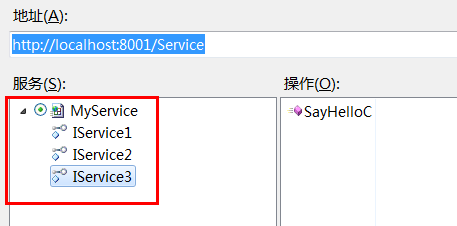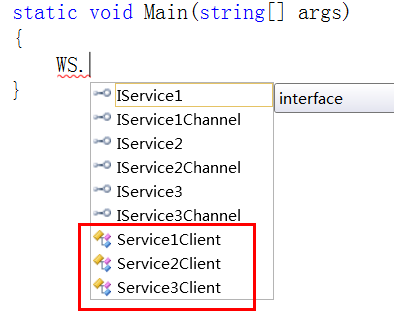我们知道,WCF服务端是先定义服务协定,其实就是一个接口,然后通过实现接口来定义服务类。那么,有一个问题,如果一个服务类同时实现N个接口(也就是有N个协定)呢?结果会如何?
不必猜,我们还是通过实验来说明吧。
首先,参照下面代码写好服务器端,代码中,我写了三个协定,然后一个服务类同时实现它们。
using System;
using System.Collections.Generic;
using System.Linq;
using System.Text;
using System.ServiceModel;
using System.ServiceModel.Description;
namespace Server
{
[ServiceContract]
public interface IService1
{
[OperationContract]
string SayHelloA();
}
[ServiceContract]
public interface IService2
{
[OperationContract]
string SayHelloB();
}
[ServiceContract]
public interface IService3
{
[OperationContract]
string SayHelloC();
}
/// <summary>
/// 实现服务协定接口的服务类
/// </summary>
class MyService:IService1,IService2,IService3
{
static void Main(string[] args)
{
using (ServiceHost host=new ServiceHost(typeof(MyService),new Uri("http://localhost:8001/service")))
{
WSHttpBinding binding = new WSHttpBinding();
binding.Name = "MyBinding";
binding.Security.Mode = SecurityMode.None;
host.AddServiceEndpoint(typeof(IService1), binding, "mysv1");
ServiceMetadataBehavior behavior = new ServiceMetadataBehavior();
behavior.HttpGetEnabled = true;
host.Description.Behaviors.Add(behavior);
host.Opened += (s, a) => Console.WriteLine("服务已启动。");
try
{
host.Open();
}
catch (Exception ex)
{
Console.WriteLine(ex.Message);
}
Console.ReadKey();
host.Close();
}
}
string IService1.SayHelloA()
{
return "你好,这是第一个服务协定。";
}
string IService2.SayHelloB()
{
return "你好,这是第二个服务协定。";
}
string IService3.SayHelloC()
{
return "你好,这是第三个服务协定。";
}
}
}
接着你试一下,在客户端引用服务,看看是什么样的?

神了,这是怎么回事呢?为什么客户端引用的服务中只有第一个协定?
还记得刚才的服务器端代码吗?请注意看我框起来的代码。

如果你上图中能找到原因,表明你悟性不错,呵呵。
注意我们添加终结点的时候,AddServiceEndpoint方法的第一个参数我们传了啥玩意儿进去了?是不是只有第一个服务协定的接口?
是啊,这上好理解了,
我们仅仅让服务类实现多个协定的接口是不够的,还要把希望对客户端公开的协定添加为终结点,对,一个协定一个终结点,不添加终结点的协定就不公开。
好了,现在找到原因了,代码知道怎么改了。
using (ServiceHost host=new ServiceHost(typeof(MyService),new Uri("http://localhost:8001/service")))
{
WSHttpBinding binding = new WSHttpBinding();
binding.Name = "MyBinding";
binding.Security.Mode = SecurityMode.None;
host.AddServiceEndpoint(typeof(IService1), binding, "mysv1");
host.AddServiceEndpoint(typeof(IService2), binding, "mysv2");
host.AddServiceEndpoint(typeof(IService3), binding, "mysv3");
ServiceMetadataBehavior behavior = new ServiceMetadataBehavior();
behavior.HttpGetEnabled = true;
host.Description.Behaviors.Add(behavior);
host.Opened += (s, a) => Console.WriteLine("服务已启动。");
try
{
host.Open();
}
catch (Exception ex)
{
Console.WriteLine(ex.Message);
}
Console.ReadKey();
host.Close();
}
看看这回达到目的了没?

嘿,这回全有了。
不过,注意啊,在生成的客户端代理类中,是按协定来划分的,也就是说,我有三个协定,在客户端代码中就生成了三个客户端类。

所以,在客户端,我们应该这样调用。
class Program
{
static void Main(string[] args)
{
WS.Service1Client client1 = new WS.Service1Client();
Console.WriteLine(client1.SayHelloA());
WS.Service2Client client2 = new WS.Service2Client();
Console.WriteLine(client2.SayHelloB());
WS.Service3Client client3 = new WS.Service3Client();
Console.WriteLine(client3.SayHelloC());
Console.ReadKey();
}
